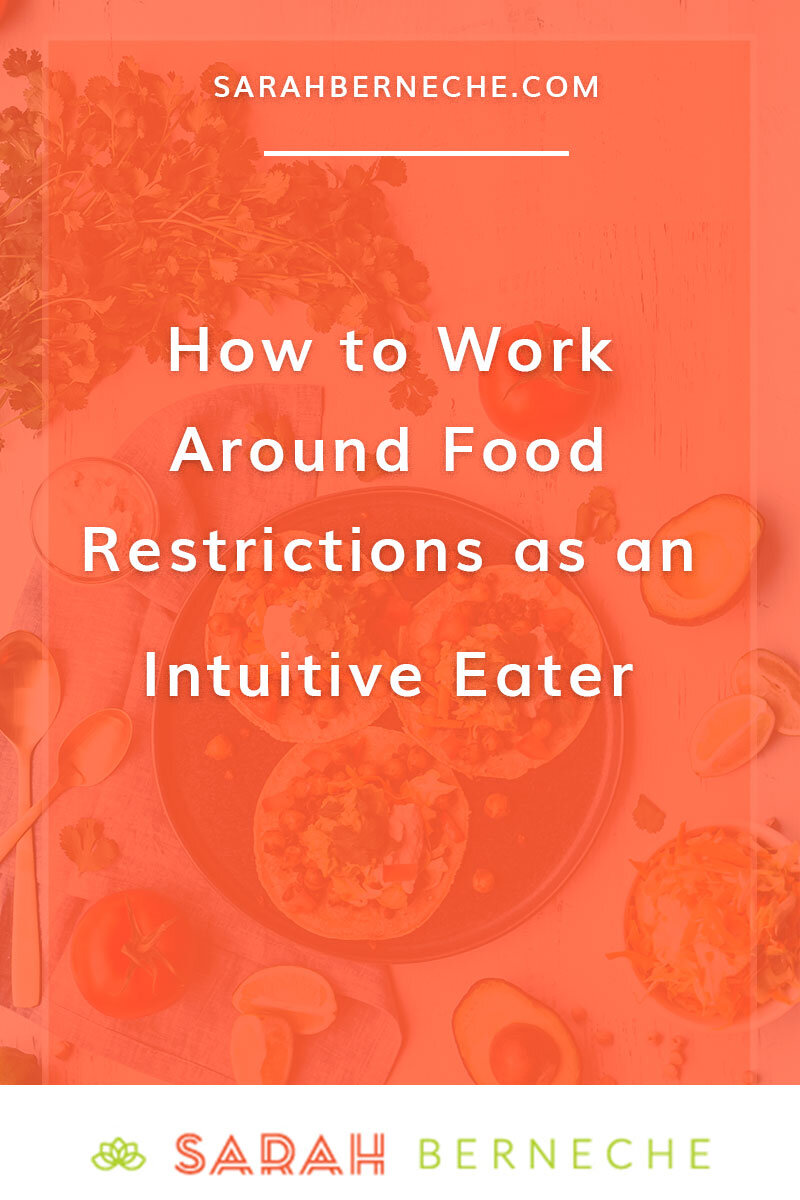Want to learn how to eat guilt-free and find food freedom? Get on the waitlist and be the first to know when doors open to the Enjoy It All Group Coaching Program!
“How do I work around food restrictions without dieting?”
“How can I honour my sensitivities and intolerances without feeling deprived?”
“Can I manage [medically mandated food restriction] while healing my relationship with food?”
If you see yourself in any of the questions above, this post is for you.
I understand the challenges of navigating food restriction as an Intuitive Eater; after all, I’ve been living with Celiac’s Disease (I cannot tolerate gluten) for over fifteen years. I like to joke that I was gluten-free before it was cool, back in the days when grocery store shelves were packed with potato pasta and a lot of cookies. And while navigating medically necessitated food restriction presents some unique challenges as an Intuitive Eater, I think it’s entirely possible to heal your relationship with food and honour your body’s needs and ethics.
Here’s 4 ways to do just that:
1. Focus on the foods that feel supportive versus dwelling on the ones that feel less so.
To be honest, when I got sick, I thought a lot about all of the foods I’d be missing out on. At the time, there were few gluten-free options available, most restaurants didn’t cater to my needs, and most people had never heard of Celiac’s Disease. It took some time before I adjusted fully, and I’ve managed to go without gluten fairly effortlessly for the last fifteen years.
Eventually, I started focusing on the foods I could eat — naturally gluten-free options — rather than dwelling on past favourites that were now off-limits (unless I wanted to feel super awful.) When I focused on all the foods that felt good in my body, my mindset shifted from one of restriction to one of abundance. It was also made easier by the fact that this wasn’t a diet in the ways we’ve come to define it, but because I’d come to find that gluten made me feel terrible and I just really wanted to feel well. If you eat a vegan or vegetarian diet for religious or ethical reasons, what about focusing on naturally vegan or vegetarian options?
2. Keep an open and curious mindset.
In Intuitive Eating, we’re encouraged to come from a place of curiosity over judgment. Try to channel it by exploring and experimenting with different foods. While I’m not much of a baker, I substituted gluten-free oat flour, buckwheat flour, chickpea flour, rice flour, and almond meal for wheat flour, tried culturally diverse recipes, and sampled new-to-me foods, like millet. This also helps to feel like you’re living in a world of abundance rather than limitation.
3. Source satisfying substitutes where possible.
If you’re intolerant to dairy, what about exploring the world of dairy-free cheeses to find a palatable substitute to go with your crackers, or using a nut parmesan for your pasta dishes? If you’re vegetarian or vegan, how about exploring the world of faux meats to give yourself more options at mealtimes? Notice what feels pleasurable and let it steer the wheel. When we focus on and prioritize pleasure — what feels good on the tongue, and depending on where you are in the intuitive eating process, what feels good in the body — we make satisfaction with food possible.
And speaking of satisfaction, what about finding alternatives to old favourites? Rather than simply forgoing foods as I would have in the past, I try to find gluten-free substitutes, like donuts, cookies, pizza, and cheeseburgers (the bun.) If you’re dairy-free, what about exploring vegan cheesecakes and desserts that are naturally free of dairy? If you’re trying to manage your blood sugar, what about working with a qualified practitioner to honour your need for fun foods (like dessert) with your need to balance your blood sugar? It doesn’t have to be all or nothing! The thing I love most about a non-diet approach is the freedom to eat in a thousand different ways, and the flexibility it offers to meet your body’s changing and varied needs — whether that looks like eating a bigger meal at lunch and a smaller meal at dinner, grazing throughout the day, or making adjustments we can live with for medical reasons.
4. Allow yourself to feel whatever you feel.
If these restrictions are new, it’s possible you’re still coping with grief. Changes of any kind, even for the better, can take time to get used to and implement fully. Try to meet these parts of yourself with tenderness and compassion. What would feel supportive to you at the moment? Can you allow yourself to feel whatever comes up? It makes sense to feel sad, angry, or fearful about these changes. What do you need to cope or sit with these feelings?

[…] from dieting to intuitive eating can be fraught with all kinds of confusion and challenges. While dieting encourages you not to […]
[…] that these are not rules; they’re guidelines to help you to become more intuitive about your food choices and to connect with your internal […]